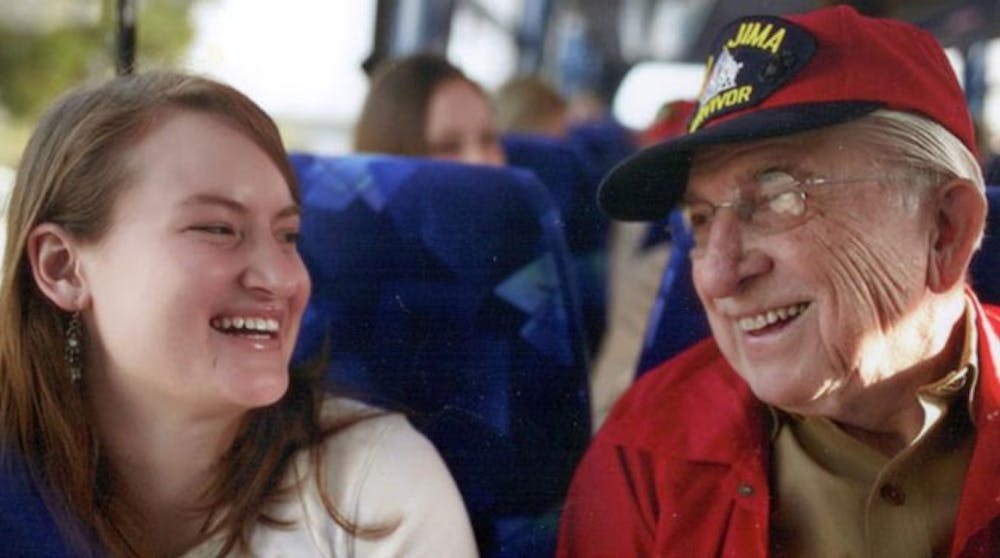"If something happens today, do you want to us to resuscitate?"
That was the question posed to almost a dozen World War II veterans as they boarded a cargo plane to revisit the black-sand beaches where they had landed under fire from Japanese forces 65 years ago.
University of Richmond Chancellor E. Bruce Heilman sat among the group of veterans as the plane left Okinawa, Japan -- the base where he had been stationed as a Marine when he was 18 years old. In three hours, they would land in Iwo Jima, Japan, where the other 10 veterans who accompanied Heilman had fought to capture the island during a 36-day battle.
Heilman, 86, is the national spokesman for The Greatest Generations Foundation, the organization that sponsored the veterans' trip to revisit the beach.
The veterans' trip to the remote, pacific island was the product of three years of planning by the foundation, an organization dedicated to honoring veterans.
On previous trips, veterans collapsed and died from the intensely emotional experience of returning to where they fought, according to a documentary about the trip by the foundation.
In the documentary, a college student looked on solemnly as Tim Davis, the head of the foundation, kneeled to ask the veteran sitting beside him whether he would like to be resuscitated if anything were to happen when they returned to the island.
"Resuscitate," the veteran said after a moment of hesitation.
The young man sitting next to the veteran nodded and his wrinkled forehead eased. He was one of the 11 student-companions from the School of the Ozarks in Point Lookout, Mo., that accompanied the veterans on the trip last March. After traveling to the islands of Okinawa and Iwo Jima, the group flew to mainland Japan to visit Hiroshima and Osaka.
The foundation invited students to accompany the veterans to promote recognition and respect for U.S. and allied war veterans and enhance their historical education -- a learning experience Heilman called "intergenerational education."
The 10 veterans who revisited Iwo Jima beside Heilman were survivors of one of the bloodiest battles in World War II.
As they walked along the island's black, volcanic sand, the veterans told the students and group of young marines about the scene they remembered, where 6,000 American troops died and 18,000 were wounded.
Enjoy what you're reading?
Signup for our newsletter
"As I watched these men bow their heads, I realized that specific faces and names were running through their minds, faces and names that were real people to them," said Rebecca Wright, a student from the School of the Ozarks. "Real buddies, real friends.
"Nothing in a history book can fully communicate the sense of loss that I am sure each of these men were feeling."
The group traveled to the summit of Mount Suribachi, where the famous picture of American troops raising the flag was taken after they defeated Japanese troops .
The photograph -- the most widely distributed in military history -- represented a pivotal time in the war, boosting morale on the island and back home.
"I want to tell their stories," Tim Davis, head of the foundation, said in an interview with HistoryNet.com. "We feel that going back, seeing what they actually fought for, meeting the new generation of the people they liberated is closure for these veterans."
Unlike the ten others, Heilman did not land on the beaches of Iwo Jima -- at the time he was still completing training for the Battle of Okinawa. But, like the others, he wore a hat that said "Iwo Jima Survivor" because of what he calls a "quirk of circumstances."
After the battle, Heilman survived a plane crash on the shores of Iwo Jima when he was an air crewman on a transport plane carrying a load of intelligence officers to the island.
Heilman, who was named national spokesman in July, will help to promote the organization at a pivotal time.
The foundation will select 30 colleges and universities, plus military academies, to invite to participate in its student-veteran companion program, Heilman said.
Heilman said the organization had not made plans to partner with Richmond, but that Richmond had not been ruled out and its renowned international center positioned the university as an excellent candidate for the program.
The foundation also plans to purchase a $16.5 million chateau in Normandy, France, that will serve as a permanent educational facility for remaining and future generations of veterans.
The name of the foundation originated from the expression coined by Tom Brokaw, "The Greatest Generation," to describe the generation who grew up during the Depression and went on to fight in World War II. But, the title of the organization pluralized Brokaw's expression because it honors and supports generations of veterans beyond World War II, as well.
Contact staff writer Kristy Burkhardt at kristy.burkhardt@richmond.edu
Support independent student media
You can make a tax-deductible donation by clicking the button below, which takes you to our secure PayPal account. The page is set up to receive contributions in whatever amount you designate. We look forward to using the money we raise to further our mission of providing honest and accurate information to students, faculty, staff, alumni and others in the general public.
Donate Now



